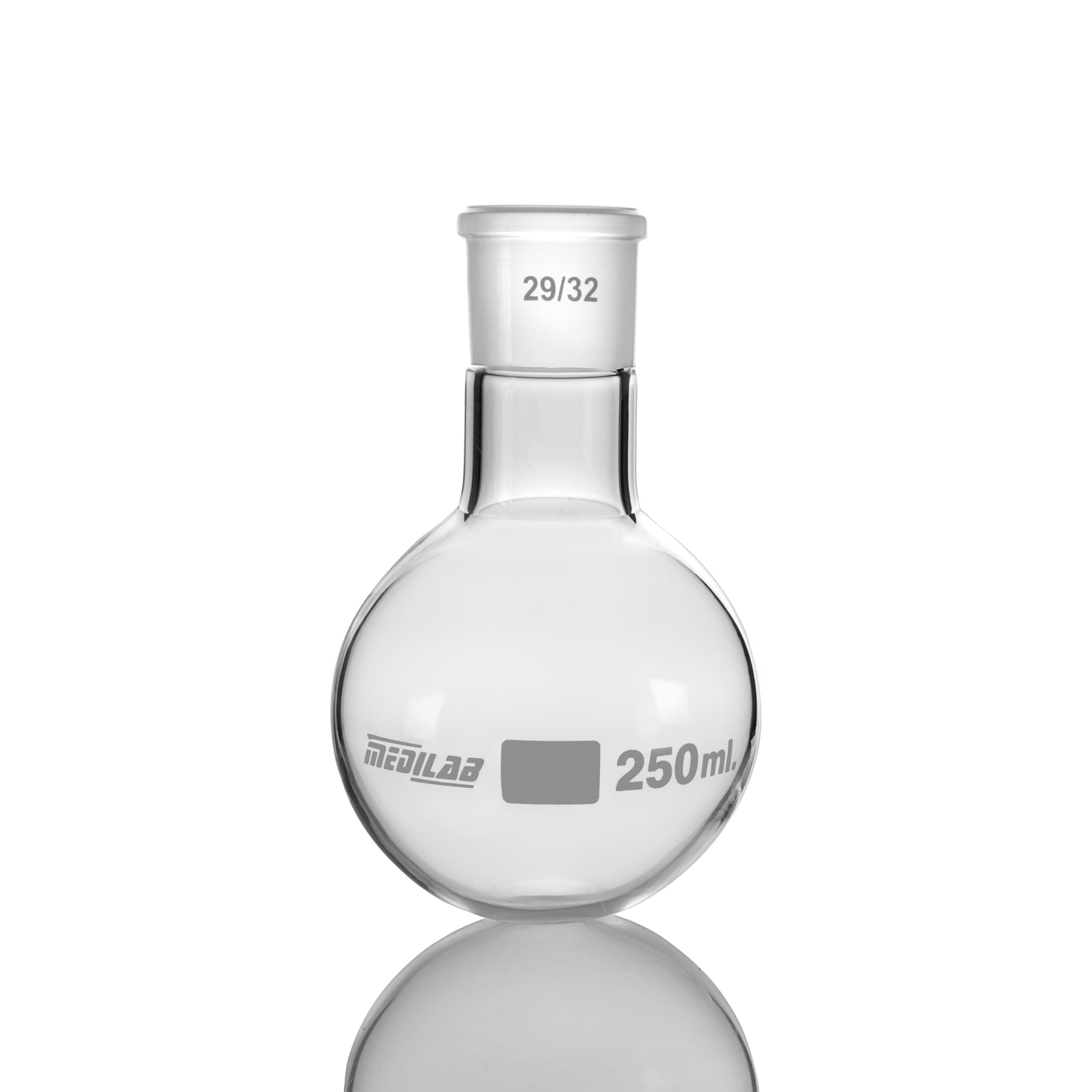Description
| Flask, Round Bottom, Single Neck | ||||
| Cat No. | Nominal capacity ml | Socket size | App. Overall Size | Dia mm |
| 11143R/1 | 50 | 14/23 | 85 | 51 |
| 11143R/2 | 50 | 19/26 | 85 | 51 |
| 11143R/3 | 50 | 24/29 | 85 | 51 |
| 11143R/4 | 100 | 14/23 | 103 | 64 |
| 11143R/5 | 100 | 19/26 | 103 | 64 |
| 11143R/6 | 100 | 24/29 | 103 | 64 |
| 11143R/7 | 250 | 24/29 | 130 | 85 |
| 11143R/8 | 250 | 29/32 | 130 | 85 |
| 11143R/9 | 250 | 34/35 | 130 | 85 |
| 11143R/10 | 500 | 24/29 | 160 | 105 |
| 11143R/11 | 500 | 29/32 | 160 | 105 |
| 11143R/12 | 500 | 34/35 | 160 | 105 |
| 11143R/13 | 1000 | 24/29 | 187 | 131 |
| 11143R/14 | 1000 | 29/32 | 187 | 131 |
| 11143R/15 | 1000 | 34/35 | 187 | 131 |
| 11143R/16 | 2000 | 29/32 | 230 | 166 |
| 11143R/17 | 2000 | 34/35 | 230 | 166 |
| Flask, Flat Bottom, Single Neck | ||||
| Cat No. | Nominal capacity ml | Socket size | App. Overall Size | Dia mm |
| 11143F/1 | 50 | 14/23 | 85 | 51 |
| 11143F/2 | 50 | 19/26 | 85 | 51 |
| 11143F/3 | 50 | 24/29 | 85 | 51 |
| 11143F/4 | 100 | 14/23 | 103 | 64 |
| 11143F/5 | 100 | 19/26 | 103 | 64 |
| 11143F/6 | 100 | 24/29 | 103 | 64 |
| 11143F/7 | 250 | 24/29 | 130 | 85 |
| 11143F/8 | 250 | 29/32 | 130 | 85 |
| 11143F/9 | 250 | 34/35 | 130 | 85 |
| 11143F/10 | 500 | 24/29 | 160 | 105 |
| 11143F/11 | 500 | 29/32 | 160 | 105 |
| 11143F/12 | 500 | 34/35 | 160 | 105 |
| 11143F/13 | 1000 | 24/29 | 187 | 131 |
| 11143F/14 | 1000 | 29/32 | 187 | 131 |
| 11143F/15 | 1000 | 34/35 | 187 | 131 |
| 11143F/16 | 2000 | 29/32 | 230 | 166 |
| 11143F/17 | 2000 | 34/35 | 230 | 166 |
The MEDILAB Round/Flat Bottom Flask with Single Neck is a precision-engineered laboratory vessel designed for heating, mixing, distillation, and general chemical processing. Its single-neck design ensures secure attachment of stoppers, condensers, and other lab accessories, making it ideal for controlled reactions. Manufactured from high-quality Borosilicate Glass 3.3, the flask offers excellent thermal stability and chemical resistance, ensuring reliable performance in both routine and advanced laboratory applications.
Key Features
- Made from premium Borosilicate Glass 3.3 for superior durability and heat resistance.
- Round/flat bottom design ensures uniform heat distribution during heating operations.
- Single neck allows easy connection to standard joint systems and laboratory equipment.
- High-clarity glass provides excellent visibility of reactions and contents.
- Resistant to strong acids, alkalis, solvents, and thermal shock.
- Smooth, stress-free glass construction for enhanced safety and long service life.
- Suitable for heating in water baths, oil baths, or with heating mantles (round bottom).
- Leak-proof joint ensures secure, airtight assembly during experiments.
Material Specifications
- Material: Borosilicate Glass 3.3
- Key Properties: High thermal shock resistance (ΔT ~ 120°C), Excellent chemical resistance to most laboratory reagents, low coefficient of thermal expansion (~3.3 × 10⁻⁶ /°C), high mechanical strength and durability
- Standards Compliance: Conforms to ISO, DIN, and ASTM standards for laboratory glassware. Manufactured in accordance with international quality and safety norms
Technical Specifications
- Available Capacities: As per the standard size table
- Design Options: Round Bottom, Flat Bottom, Single Standard Neck with Standard Joint (custom joint sizes available)
- Dimensions: Diameter, height, and joint size vary as per individual capacity. Precision-blown for dimensional accuracy
- Tolerance: Manufactured with tight tolerances for consistent performance
- Calibration Details: Not a calibrated volumetric vessel (general purpose flask)
- Accessories (Optional): Glass stoppers, Joint clips, Custom labeling
Handling & Precautions
- Avoid direct flame contact unless using an appropriate round-bottom heating support.
- Ensure uniform heating to prevent thermal stress.
- Do not subject the flask to sudden temperature changes.
- Suitable for autoclaving up to recommended temperature limits.
- Use appropriate cleaning agents; avoid abrasive scrubbers to maintain clarity.
- Inspect joints regularly for chips or cracks before use.
- Store in padded racks or protective holders to avoid mechanical impact.
Applications
- Ideal for chemical reactions, heating, boiling, and solvent distillation.
- Widely used in organic synthesis, sample preparation, and reflux setups.
- Perfect for use in pharmaceuticals, biotechnology labs, chemical industries, academic research, and QC/QA environments.
- Supports daily laboratory workflows such as solution preparation, compound evaporation, and controlled heating processes.
- Preferred for rotary evaporators (round bottom type) and analytical research setups.







